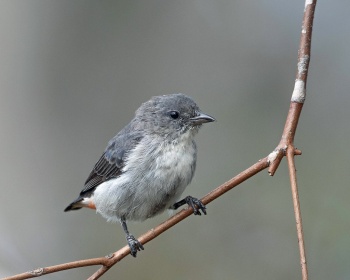Sbarnhardt (talk | contribs) (Edited username Mzungu to Ken Doy x 1 & image pixel to 500px) |
(Juvenile ID started. Picture of juvenile. References updated) |
||
| Line 12: | Line 12: | ||
*Light grey belly | *Light grey belly | ||
*Slight red tinge under the tail | *Slight red tinge under the tail | ||
| − | + | '''Juvenile''' has an orange bill with a black tip | |
==Distribution== | ==Distribution== | ||
[[Australia]], [[Papua New Guinea]], and eastern [[Indonesia]]. | [[Australia]], [[Papua New Guinea]], and eastern [[Indonesia]]. | ||
==Taxonomy== | ==Taxonomy== | ||
| + | [[Image:Mistletoe Bird 2 1 of 1 .jpg|thumb|350px|right|Sub-adult male<br />Photo © by {{user|Ken+Doy|Ken Doy}}<br />Sandy Camp Rd Wetlands, [[Queensland]], [[Australia]], June 2018]] | ||
====Subspecies==== | ====Subspecies==== | ||
There are 4 subspecies<sup>[[#References|[1]]]</sup>: | There are 4 subspecies<sup>[[#References|[1]]]</sup>: | ||
| Line 27: | Line 28: | ||
:*Islands in Torres Strait and treed areas of mainland [[Australia]] | :*Islands in Torres Strait and treed areas of mainland [[Australia]] | ||
==Habitat== | ==Habitat== | ||
| − | [[ | + | [[File:20210223- MG 9621.jpg|thumb|350px|right|Juvenile<br />Photo © by {{user|thunor|thunor}}<br />Cobar, [[New South Wales]], [[Australia]], 23 February 2021]] |
Trees and shrubs; anywhere where mistletoe grows. | Trees and shrubs; anywhere where mistletoe grows. | ||
==Behaviour== | ==Behaviour== | ||
| Line 37: | Line 38: | ||
<sup>*</sup>Most on-line sources state that only the female builds the nest, but [http://www.birdforum.net/gallery/showphoto.php?photo=430459 this picture] shows a male collecting nesting material from a palm. | <sup>*</sup>Most on-line sources state that only the female builds the nest, but [http://www.birdforum.net/gallery/showphoto.php?photo=430459 this picture] shows a male collecting nesting material from a palm. | ||
==References== | ==References== | ||
| − | #{{Ref-Clements6thAug19}}# | + | #{{Ref-Clements6thAug19}}#Bird Forum Member observations |
| − | # | + | #Cheke, R., J. del Hoyo, N. Collar, C. Mann, and G. M. Kirwan (2020). Mistletoebird (Dicaeum hirundinaceum), version 1.0. In Birds of the World (S. M. Billerman, B. K. Keeney, P. G. Rodewald, and T. S. Schulenberg, Editors). Cornell Lab of Ornithology, Ithaca, NY, USA. https://doi.org/10.2173/bow.mistle1.01 |
{{ref}} | {{ref}} | ||
==External Links== | ==External Links== | ||
Revision as of 22:50, 8 June 2021
- Dicaeum hirundinaceum
Identification
9 cm (3½ in)
- Bluish-black plumage
- Red chest
- Red undertail
- White belly with black centre stripe
Female
- Dark grey upperparts
- Light grey belly
- Slight red tinge under the tail
Juvenile has an orange bill with a black tip
Distribution
Australia, Papua New Guinea, and eastern Indonesia.
Taxonomy
Subspecies
There are 4 subspecies[1]:
- D. h. kiense:
- Southern Wallacea (Watubela, Tayandu and Kai islands)
- D. h. fulgidum:
- Tanimbar Island (Yamdena, Larat and Lutu)
- D. h. ignicolle:
- Aru Islands
- D. h. hirundinaceum:
- Islands in Torres Strait and treed areas of mainland Australia
Habitat
Trees and shrubs; anywhere where mistletoe grows.
Behaviour
Diet
Their diet consists of mistletoe berries, fruit, nectar, pollen, spiders, moths, .
Breeding
Both adults build the nest* of crushed plants, palm threads and spider webs.
*Most on-line sources state that only the female builds the nest, but this picture shows a male collecting nesting material from a palm.
References
- Clements, J. F., T. S. Schulenberg, M. J. Iliff, S. M. Billerman, T. A. Fredericks, B. L. Sullivan, and C. L. Wood. 2019. The eBird/Clements Checklist of Birds of the World: v2019. Downloaded from http://www.birds.cornell.edu/clementschecklist/download/
- Bird Forum Member observations
- Cheke, R., J. del Hoyo, N. Collar, C. Mann, and G. M. Kirwan (2020). Mistletoebird (Dicaeum hirundinaceum), version 1.0. In Birds of the World (S. M. Billerman, B. K. Keeney, P. G. Rodewald, and T. S. Schulenberg, Editors). Cornell Lab of Ornithology, Ithaca, NY, USA. https://doi.org/10.2173/bow.mistle1.01
Recommended Citation
- BirdForum Opus contributors. (2024) Mistletoebird. In: BirdForum, the forum for wild birds and birding. Retrieved 4 June 2024 from https://www.birdforum.net/opus/Mistletoebird







